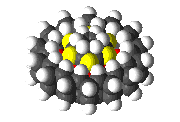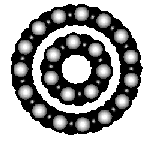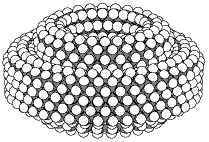 A Proof About Molecular Bearings
A Proof About Molecular Bearings A Proof About Molecular Bearings
A Proof About Molecular BearingsFurther information about nanotechnology is available at http://www.zyvex.com/nano.
Drexler[1, 5] pointed out that these problems can be solved by the use of atomically precise bearings. The structure of a simple molecular bearing might be defined by taking two flat sheets of some material, bending them into two hoops of slightly differing diameter, and inserting the smaller hoop into the larger hoop. (This is a description, not necessarily a manufacturing method). Such a bearing is illustrated in figure 1 which shows a simple bearing made of two graphite sheets, with hydrogen terminating the dangling bonds that would otherwise occur at the edges of the sheets. The ability to synthesize this specific bearing has not been demonstrated, so the present analysis is theoretical (although there has been recent experimental work on structures that are generally similar[7]). Some system-level contexts in which molecular bearings would be useful have been discussed in Nanosystems.
 Figure 1.
Figure 1.
 Figure 1, end view.
Figure 1, end view.
Molecular bearings can be "run dry", as first suggested by Feynman[4]. If the surfaces are atomically precise, the problem of wear can be avoided. Such an atomically precise surface is either perfect, or is broken because one or more atoms are out of place. If, however, the forces on the surface atoms are insufficient to dislodge them (and because the surfaces are atomically precise, the load can be distributed quite evenly) then the wear on the bearing (in the conventional sense) becomes zero. Bearing lifetime is no longer limited by wear. In our graphite bearing, continued rotation of the shaft within the sleeve will not cause the molecular structure to spontaneously disintegrate.
Friction in a macroscopic bearing is caused by surface irregularities. Typical macroscopic objects have rough surfaces (when viewed from the atomic scale), and these grind over each other. This process dislodges particulates and produces significant changes in the structure of the two surfaces. In an atomically precise molecular bearing, this need not occur and so friction in the conventional sense need not exist. However, while conventional friction is not a problem, it might still be the case that the bearing has certain preferred positions. That is, when we rotate the shaft with respect to the sleeve the potential energy of the system will increase and decrease periodically. While this process need not dissipate significant amounts of energy, it does mean that the "bearing" will have certain preferred orientations. If the change in potential energy is sufficiently large, the bearing would "stick" at certain preferred orientations and fail to rotate.
Graphite is used as a lubricant, and so one might expect that the graphite bearing illustrated in figure 1 would have low "static friction" for this reason alone. The bearing illustrated in figure 2 consists of two sheets of 111 diamond that have been bent into two hoops. Again, the smaller hoop has been inserted into the larger hoop to produce the bearing. The structure is chemically very simple. It uses only two atom types: carbon and hydrogen; and only two bond types: carbon-carbon single bonds and carbon-hydrogen bonds. In this bearing it is perhaps less obvious that the barrier to rotation should be small, although this is the case.
 Figure 2.
Figure 2.
While this result is intuitively obvious, it is sufficiently important that it warrants a closer and somewhat more formal examination. Bearings are, after all, an essential component in conventional macroscopic machines, and it is reasonable to expect they will have equal importance in molecular machines. The conditions that must be met to insure adequate performance of molecular bearings are therefore worth more careful examination.
We shall assume that the shaft has m-fold symmetry and angular orientation Q; while the sleeve has n-fold symmetry and angular orientation F.
symmetry angular position
shaft m-fold Q
sleeve n-fold F
We assume that the shaft and sleeve have perfect symmetry and are initially positioned with Q=Q0
and F=F0.
We first note that rotation of the shaft by q/m or the rotation of the sleeve by r/n (for arbitrary integers q and r) produces a structure which is physically isomorphic with the original structure in which Q=Q0 and F=F0. Now, the relative angular rotation, R, between the shaft and the sleeve is simply Q-F. That is, by definition:
(1) R = Q - F
and by the symmetries of the shaft and sleeve, a bearing B1 in which R1 = Q1 - F1 is isomorphic to the initial bearing B0 in which R0 = Q0 - F0 when there exist two integers q and r such that:
(2) Q1 - Q0 = q/m
and
(3) F1 - F0 = r/n
(we define a single 360 degree rotation as having the value 1. Thus, a rotation of 1/4 would be, by definition, equal to 90 degrees).
(1), (2) and (3) imply B1 will be isomorphic with B0 when R1-R0 = (Q1 - F1) - (Q0 - F0) = (Q1 - Q0) - (F1 - F0) = q/m - r/n
or
(4) R1-R0 = (q*n - r*m)/(m*n)
There are integers i and j such that
(5) GCD(m,n) = i*m + j*n
(This is a theorem from elementary number theory. See, for example, [6] page 4).
By setting q=j and r=-i, equation (4) becomes:
(6) R1-R0 = (j*n + i*m)/(m*n)
or
(7) R1-R0 = GCD(m,n)/(m*n)
Thus, a relative angular rotation of GCD(m,n)/(m*n) produces a structure which is isomorphic with the original. By multiplying equation (5) by an arbitrary integer, we can obtain the result that a bearing B1 is isomorphic to a bearing B0 if
(8) R1-R0 = p*GCD(m,n)/(m*n) for any integer p
Of course, isomorphic structures (which differ only in their spatial orientation) must necessarily have the same potential energy. If we let E(R) be the function describing the potential energy of the system as a function of relative angular rotation, then we have just proven that:
(9) E(R) = E(R+p*GCD(m,n)/(m*n)) for any integer p
i.e., we have proven that the energy of the system is periodic, with period GCD(m,n)/(m*n). By selecting m and n so that GCD(m,n) is small, we can effectively create a short period. In particular, if GCD(m,n)=1, i.e., m and n are relatively prime, then the period will be 1/(m*n).
Here, too, we can prove a similar result. In our proof that idealized rigid bearings were periodic with period GCD(m,n)/(m*n), we proved that changing the relative angular rotation of the bearing by GCD(m,n)/(m*n) was equivalent to permuting the labels of the atoms in the bearing. In a real bearing it is also possible to apply the same permutation to the atoms, again resulting in a rotation of GCD(m,n)/(m*n). Because the structures differ only in the labels, and are physically isomorphic, they will of course have the same energies. Thus, real bearings also have an energy which is periodic with period GCD(m,n)/(m*n).
While generally true, this observation can be false under special circumstances. It is normally possible, if the atoms in the bearing are labeled, to determine the relative angular rotation of a bearing to within multiples of whole rotations. However, this is not strictly a logical necessity. If the bearing is composed of a collection of "black hole" atoms that swallow everything, then the bearing will lose all symmetry when it is relaxed, because the "black hole" atoms will collapse into a single point. This point will have no symmetry at all, and will have only a single minima (not (m*n)/GCD(m,n) distinct minima). In real structures that are chemically stable, this is unlikely to occur.
An example of such a bad bearing might be taken from the "Wheel of Fortune." In this structure, the shaft might have m equally spaced nails, while the sleeve might have n equally spaced sticks that insert into the spaces between the nails. When the wheel is spun, the sticks will clatter against the nails. As a given nail is on the very verge of passing a given stick, a slight forward motion of the shaft will cause the stick to clatter down behind the nail. A slight backwards motion of the shaft will then fail to restore the stick to its proper place, thus resulting in two distinct energy minima for the same relative angular rotation R.
This kind of "popping" or "snapping" action must be avoided for the bearing to operate smoothly. In general, if the atoms along the surface of the bearing are well anchored with respect to motion around the bearing, this kind of problem should not occur. Molecular mechanics modeling of proposed bearing structures can be used to determine if this kind of situation exists.
Further, although E(R) is periodic, this does not by itself provide any guarantees about the size of the barrier that separates two adjacent minima. However, in reasonable situations in which relatively prime and reasonably large values of m and n are used, the displacement caused at the bearing surface by an angular rotation of 1/(n*m) will be a modest fraction of an angstrom. If the shaft repeats its structure every 2 or 3 angstroms (as would occur if the inner surface were graphite), and if the sleeve has an n value between 10 and 20, then 1/(m*n) corresponds to a displacement of about 0.1 to 0.2 angstroms. The normal spacing between sheets in graphite is about 3.4 angstroms, and we can reasonably assume that the spacing between the outer atoms of the inner bearing and the inner atoms of the outer bearing will not be greatly smaller than 3 angstroms. There should be no abrupt changes in energy and force as the atoms in the shaft move 0.1 to 0.2 angstroms with respect to the atoms in the sleeve that are some 3 angstroms away, particularly in surfaces (such as graphite) that were deliberately chosen to be as smooth as possible. Larger values of m and n would further reduce this.
We have also not examined the behavior of the bearing under load. Some analysis of this general problem has been done by Drexler[1, 5], who showed that molecular bearings can be designed with good performance even when relatively large loads are applied. Again, molecular mechanics models can be used to determine the behavior of a specific bearing under load.
The theorem proved here applies to any shaft and sleeve which obey the symmetry conditions. A very wide range of molecular structures which exhibit suitable symmetry can be used. Thus, it is possible in principle to construct "good" molecular bearings from a very wide range of materials by paying attention to the symmetries of the shaft and sleeve.
 This
page is part of the
nanotechnology web site.
This
page is part of the
nanotechnology web site.